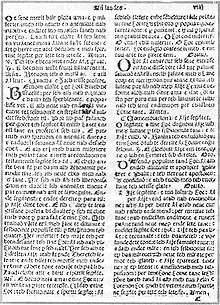Upravo sam čuo u jednoj emisiji da je Dositej čekao brod u Draču par meseci (jer je takav bio raspored vožnje tada) i on jr iznajmio dtan u gradu i primetio kako ljudi tu nrmaju zabeležene oznake za glasove koje koriste u govoru te je odlučio da im smisli pismo.. Da li je to stvarno istina? Da li neko ima postoje neki podaci o tome?
Da Dositej, osim dugog cekanja u Dracu, nema veze s albanskom azbukom ima puno dokaza:
Gjon Buzuku
From Wikipedia, the free encyclopedia
Jump to navigation Jump to search

A page from the
Meshari.
Gjon Buzuku (16th century) was an
Albanian Catholic priest who wrote the first known printed book in
Albanian. Gjon Buzuku was born in the village of Ljare (
Krajina,
Albanian:
Krajë) in the
Bar district, close to Northern Albania (Krajë is located on the shores of
Skadar Lake), then
Ottoman Empire. He probably lived in or near
Venice,
Italy. There are claims that he was the
bishop of two
dioceses in north Albania or that he was a
monk.
From March 20, 1554 to January 5, 1555 he wrote a translation of the Catholic
missal into the
Gheg dialect of Albanian. He published it as a book of 188 pages. The
Apostolic Library in the
Vatican holds the only known copy of the book. It is missing the
frontispiece and the first 16 pages, which explains why the title and year of publication of the work are not known.
The book was discovered in 1740 by
Gjon Nikollë Kazazi, the
archbishop of Skopje. In other libraries there are three photocopies from the original, one of them in
Tirana. In 1996, the librarians were not able to locate the book, which had been used in 1984 for the last time.
Eqrem Çabej wrote a monograph on the book in 1968. The dialect used in
Mëshari was one of the main subjects of
Selman Riza's works.
[1]
The place the book was printed is thought to be either
Venice or
Shkodër.
The book contains the liturgies of the main
holidays. There are also texts of prayers and rituals and
catechetical texts. Every page contains two columns. The initials are decorated. The grammar and the vocabulary are more archaic than in the Gheg text from the 17th century. The text is very valuable from the viewpoint of the history of language. The vocabulary is quite rich. The archaic text is easily read due to the circumstance that it is mainly a translation of known texts, in particular the
Bible. Most of the
Gospels of Matthew,
Luke and
John were translated in the book. It also contains passages from the
Psalms, the
Book of Isaiah, the
Book of Jeremiah, the
Letters to the Corinthians, and many illustrations.
The
orthography is peculiar. The
Latin alphabet with some additional letters is used. The consequent character of orthography and grammar seems to indicate an earlier tradition of writing.
In Albanian, the book is known as
Meshari (
The Missal). All we know about the author is from the book's
colophon written by Buzuku himself in Albanian. Language used is a pre-runner to the Official Gheg Albanian Language. However, it is clear that the Gheg dialect was used. Even today one can hear words and expressions from older Malësians that sound as if jumping from the pages of the missal.
Isitom azbukom pisane su dve knjige na albanskom od Pjeter Budi, (
1566-
1622),
Rituale Romanum or
Rituali Roman (
Roman Ritual) i
Speculum Confessionis or
Pasëqyra e t'rrëfyemit ,
Frang Bardhi (
Latin:
Franciscus Blancus,
Italian:
Francesco Bianchi, 1606–1643) was an
Albanian Catholic bishop and writer,knjige
The Apology of Scanderbeg i Diktionaium latino-epiroticum,(
Le Dictionnaire albanais de 1635, édité avec introduction et index complet, par Mario Roques. I : Dictionarium latino-epiroticum, per R. D. Franciscum Blanchum (1932) kao i remek delo, kako procenjuje
Čedomilj Mijatović, Pjetra Bogadija, Cuneus profetarum,1685, Padova.

